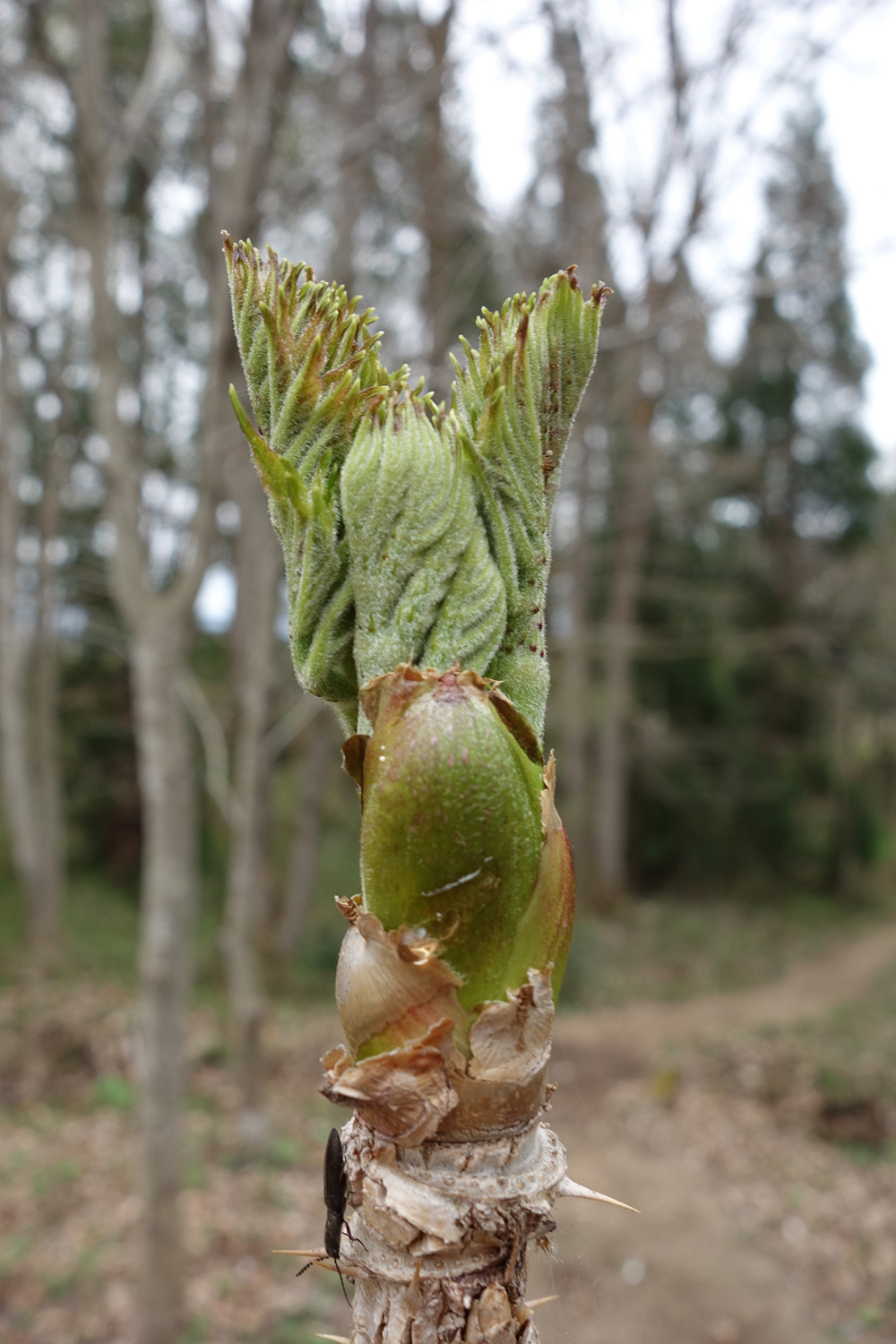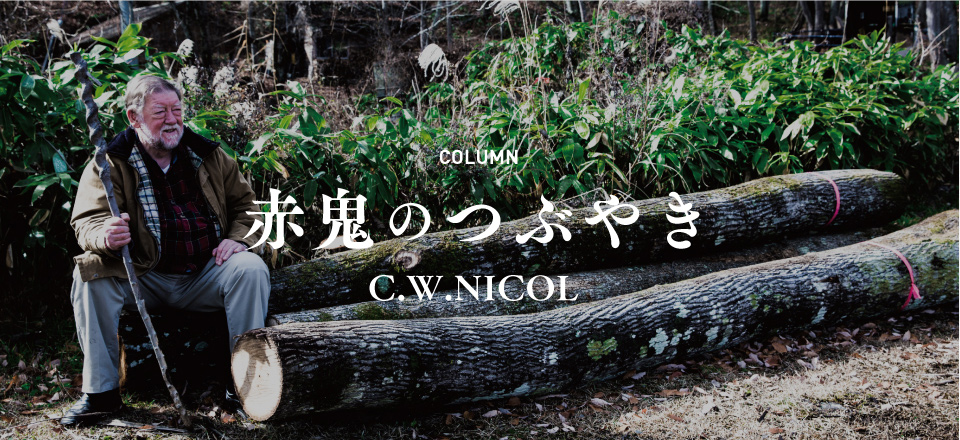Column
【赤鬼のつぶやき C.W.ニコル】タラノキ Japanese angelica tree (学名Araila elata)
私のお気に入りの山菜のひとつに「タラの芽」があります。名前のとおり、タラノキの新芽です。タラノキは英語でJapanese angelica tree(学名Araila elata)、幹をまっすぐ伸ばす落葉低木で、韓国や中国、ロシアにも仲間が分布しています。春の終わりから夏の初めにかけて、アファンの森を訪れる皆さんは、たいてい「タラの芽の天ぷら」はご存じなのに、肝心のタラノキがどういう植物かを全く知らない人の多さには驚くばかりです。米国にもよく似た種(学名Arailia spinosa)が生息していて、「悪魔の杖(devil’s walking stick)」の別名で知られていますが、今回、私は日本語の名前である「タラ」を使いたいと思います。

タラノキは、高さ数メートルまで伸びますが、幹の太さが直径5センチメートルを超えることはめったにありません。長く伸びた幹の先端に芽をつけます。樹皮は粗く、色は灰色で、鋭いトゲがたくさんあります。タラの葉は、アファンの森に生えている木や灌木の中でも一番大きくて、長さは60~120センチメートルにも達します。といっても、茎の両側に小さな葉が何枚もついてひとまとまりになった「複葉」と言われる葉っぱで、小さな葉の一つ一つは長さ2~3センチメートルです。夏の終わり頃、花をつけます。散形花序といって、茎の先に小さな白い花がたくさん集まって一つの大きな花のように見えるのが特徴です。これらの花が順番に小さな黒い実(核果)をつけ、それぞれに一粒ずつ種ができます。この実は鳥たちの大好物です。
タラノキは太陽の光が大好きなので、アファンの森で新しい苗木を植えるために木々を伐採したり、密集した葉を刈り込んだりして日当たりがよくなると、とたんに伸びてきます。そして、何年かたって植えた木々が成長し、日差しが遮られるようになると、枯れてしまうのです。といっても、アファンではいつでも植林や間伐をしているので、森からタラの芽がなくなることはありません。

私としては、つぼみが開いて新芽が顔をのぞかせたら、まだ緑色でやわらかいうちに採るのがいいと思っています。芽を全部採ってしまうと木が枯れて、やがてはタラノキが全滅してしまうので、親株のために必ず新芽のいくつかは残すようにしています。タラの芽は、天ぷらにするほか、バターかオリーブオイルでサッと火を通し、塩コショウしたところに白ワインを振りかけて蒸し焼きにすることもあります。中華風に強火で炒めても美味しい一品になります。

タラノキが外来種の灌木として米国に持ち込まれたのは1830年のことですが、鳥たちが種をばらまいたおかげで繁殖し、今では在来種を脅かす侵入種と見られています。アメリカ人がタラの芽を食べるという話は聞いたことがありませんが(日本に来て、その美味しさを知った場合は別として)、アメリカ先住民は原産種である「悪魔の杖」の新芽を野菜として料理し、黒い実も食べていました。
C.W.ニコル
2019年1月
写真提供:C.W.ニコル・アファンの森財団
TARA NO KI
One of my favourite mountain vegetable (sansai) treats is ‘tara no me,’ or the buds an angelica tree, Araila elata. It is a small upright woody shrub, with similar species native to Korea, China and Russia. Visitors to our Afan woods in late spring or early summer usually know about ‘tara no me’ tempura, but a surprisingly large number of them have no idea of what the plant is like. There is a very similar species native to America, Arailia spinosa, that is called ‘devil’s walking stick’ but in this article I will use the common Japanese name, ‘tara.’
Tara can grow to several metres in height but the trunk rarely reaches more than five or so centimetres in diameter. The buds grow at the end of the long thorny trunk.
The bark is rough and grey in colour, with lots of prickly thorns. The leaves are the largest of all the trees and shrubs in our woods, growing to be 60 to 120 centimetres in length. A single leaf is comprised of alternate green branches with small green leaflets, these being 2-3 centimetres long. In late summer the tara grows large umbels, bunches of tiny white flowers. These in turn produce small black drupes or berries, each with a single seed. Birds love them.
Tara prefers lots of sunlight, so they grow when we clear woodland for replanting or when we have severely trimmed out densely growing leaves. After a few years, as the trees grow and take more of the sunlight, the tara dies out. However, as we always have ongoing work in the woods, we never run out of ‘tara no me.’
Personally, partly in order not to kill off the tara, I prefer to harvest young shoots that grow from the buds when the young shoots are still green and tender. I always leave some of the shoots for the parent plant. Sometimes I prepare tara shoots as tempura, but I also cook them with butter or olive oil, flavoured with salt and pepper, with a dash of white wine to steam them. Tara shoots are also good in Chinese style stir-fries.
Tara was introduced to the United States in 1830 as an exotic shrub, but birds spread the seeds and now it is viewed as an invasive species. I have never heard of Americans eating ‘tara no me’ (unless they had learned of this delicacy in Japan) but native Americans used their own ‘devil’s walking stick’ shoots as pot herbs. They also ate the black berries.
C.W.Nicol
January 2019
C.W.ニコル
作家・1940年イギリス南ウェールズ生まれ。1995年日本国籍取得。カナダ水産調査局北極生物研究所の技官・環境局の環境問題緊急対策官やエチオピアのシミエン山岳国立公園の公園長など世界各地で環境保護活動を行い、1980年から長野県在住。1984年から荒れ果てた里山を購入し「アファンの森」と名づけ、森の再生活動を始める。2005年、その活動が認められエリザベス女王から名誉大英勲章を賜る。2011年、2016年に天皇、皇后両陛下がアファンの森をご視察された。





